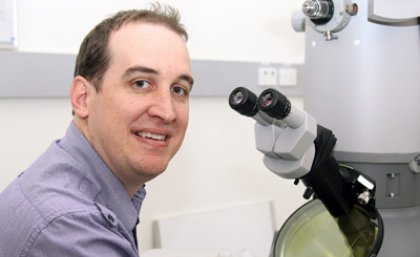
A team of Australian and New Zealand researchers are harnessing bacteria as a possible new bio-insecticide to control crop pests.
The team, which includes Dr Michael Landsberg from The University of Queensland’s Institute for Molecular Bioscience, investigated the workings of Yersinia entomophaga, a bacteria that kills a range of insect species that damage crops.
In the process, the researchers discovered an entirely new way in which cells produce and store toxins.
The team, led by Drs Shaun Lott from AgResearch and the University of Auckland and Mark Hurst from AgResearch together with Jason Busby from the University of Auckland, Dr Santosh Panjikar from the Australian Synchrotron and Dr Landsberg, published their findings overnight in leading scientific journal Nature.
“We showed that the bacteria manufactures a giant, hollow protein shell that encapsulates the toxin, much like a protective canister that is only opened when specific environmental conditions are encountered,” Dr Landsberg said.
“This explains how the bacteria can produce toxins without harming themselves – the toxins are secured in the protein shell and released at an appropriate time, which is what kills the insect.
Dr Landsberg said the bacteria’s ‘blueprint’ for producing this canister uses a repeating protein sequence that is found in large numbers in other bacteria and animals.
“While the sequence encoding the shell is conserved across species, the toxins or other encapsulated molecules can be quite different,” he said.
“Our studies suggest we may have found a molecular assembly manual that bacterial and animal cells alike use to manufacture a generic canister for the protection of toxic or sensitive molecules.
“This has implications for research into human disease as well as pesticides.”
The bacteria was originally discovered in the native New Zealand grass grub by Dr Mark Hurst from AgResearch in Lincoln, but it was the discovery that it also affected insects such as the diamondback moth, which damages crops worldwide, that piqued the team’s interest.
To donate to IMB’s insecticide research please visit www.imb.uq.edu/donate or call (07) 3346 2132.
The Institute for Molecular Bioscience (IMB) is a research institute of The University of Queensland that aims to improve quality of life by advancing personalised medicine, drug discovery and biotechnology.
AgResearch is New Zealand’s largest Crown Research Institute and partners with the pastoral sector to identify and deliver the innovation that is needed to create value for the country.
Media: Bronwyn Adams, IMB Communications Officer 0418 575 247 or 07 3346 2134 or b.adams@imb.uq.edu.au
.jpg)


